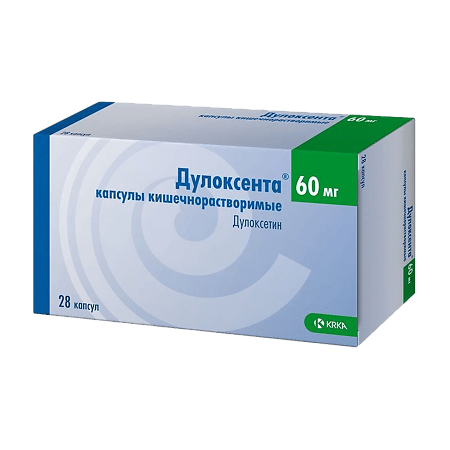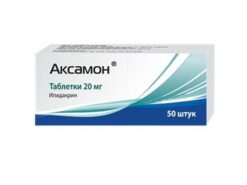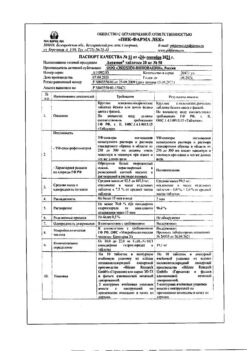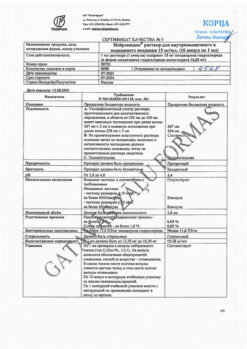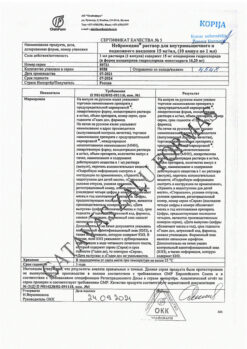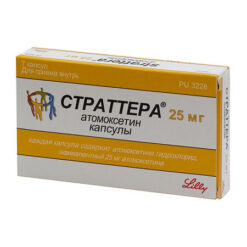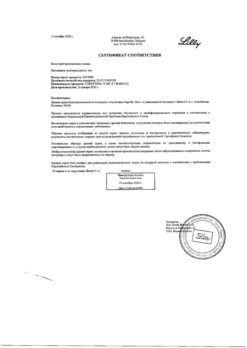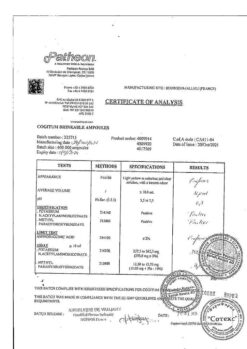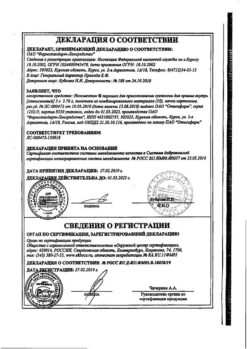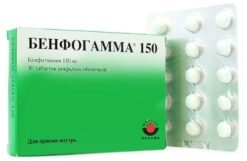Subtotal: €43.70
Duloxenta, 60 mg 28 pcs
€82.67 €68.89
– Depression.
– Painful form of peripheral diabetic neuropathy.
– Generalized anxiety disorder.
– Chronic musculoskeletal pain syndrome (including those due to fibromyalgia, chronic pain syndrome in the lower back and in osteoarthritis of the knee).
Indications
· Depression.
· Painful form of peripheral diabetic neuropathy.
· Generalized anxiety disorder.
· Chronic pain syndrome of the musculoskeletal system (including those caused by fibromyalgia, chronic pain syndrome in the lower back and osteoarthritis of the knee joint).
Pharmacological effect
antidepressant
Special instructions
Mania and bipolar disorder (including a history), seizures (including a history), intraocular hypertension or the risk of developing an acute attack of angle-closure glaucoma, a history of suicidal thoughts and attempts, an increased risk of hyponatremia (elderly patients, cirrhosis of the liver, dehydration, taking diuretics), impaired liver function and renal failure (KF) 30-60 ml/min).
Duloxetine is not recommended for use in children under 18 years of age due to insufficient data on its safety and effectiveness when used in this age group of patients.
Renal dysfunction
With a CC of 30-80 ml/min, no dose adjustment is required; with a CC of less than 30 ml/min, the use of Duloxent® is contraindicated.
Liver dysfunction
Duloxent® should not be prescribed to patients with liver diseases accompanied by liver failure.
Age
For the treatment of generalized anxiety disorder, an initial dose of 30 mg/day is recommended for elderly patients for 2 weeks before starting duloxetine at a target dose of 60 mg/day. In the future, it is possible to use the drug at a dose of over 60 mg/day to achieve a good result. A systematic evaluation of drug intake at doses above 120 mg/day has not been carried out. When using duloxetine for other indications, dose adjustment is not required depending on the patient’s age.
Exacerbation of manic/hypomanic state
As with similar drugs that affect the central nervous system, duloxetine should be used with caution in patients with a history of manic episodes.
Epileptic seizures
As with similar drugs that act on the central nervous system, duloxetine should be used with caution in patients with a history of epileptic seizures.
Midriaz
Cases of mydriasis have been observed with duloxetine, so caution should be exercised when using duloxetine in patients with elevated intraocular pressure or in those at risk of developing acute angle-closure glaucoma.
Increased blood pressure
In isolated cases, a rise in blood pressure was observed during treatment with duloxetine. In patients with arterial hypertension and/or other cardiovascular diseases, it is recommended to measure blood pressure.
Impaired kidney and liver function
In patients with severe renal impairment (creatinine clearance <30 ml/min) or severe liver failure, an increase in the concentration of duloxetine in the blood plasma is observed. If duloxetine is clinically justified in such patients, lower initial doses of the drug should be used.
Suicidal behavior
The risk of committing suicide exists in all patients with depression and some other mental disorders. This danger may persist until remission occurs. As a result, patients at greatest risk of committing suicide should be under close medical supervision during pharmacotherapy. As well as taking other drugs that have a similar mechanism of pharmacological action to duloxetine (SSRIs, SNRIs), taking duloxetine during treatment or upon its cessation in a number of cases was associated with the development of suicidal thoughts and suicidal behavior. Duloxetine has not been studied in patients under 18 years of age and therefore duloxetine is not intended for use in such patients. A cause-and-effect relationship between taking duloxetine and the occurrence of suicidal events in patients of this age group has not been established. However, some analytical reviews of the results of a number of studies using antidepressants for the treatment of mental disorders indicate an increased risk of developing suicidal thoughts and/or suicidal behavior in children, adolescents and adults under 25 years of age compared with placebo. Clinicians should encourage patients to report any disturbing thoughts and feelings at any time.
Sexual dysfunction
SSRIs/SNRIs may cause symptoms of sexual dysfunction. There have been reports of long-term sexual dysfunction in which symptoms persisted despite discontinuation of SSRIs/SNRIs.
Increased risk of bleeding
SSRIs and SNRIs, including duloxetine, may increase the risk of bleeding, including gastrointestinal bleeding (see section “Side effects”). Therefore, duloxetine should be used with caution in patients taking anticoagulants and/or drugs that affect platelet function (for example, non-steroidal anti-inflammatory drugs, including aspirin), and in patients with a history of bleeding.
Hyponatremia
Very rarely, cases of hyponatremia have been reported (in some cases, serum sodium levels were lower than 110 mmol/l). Most of these cases occurred in elderly patients, especially in combination with a recent history of altered fluid balance or in the presence of conditions predisposing to altered fluid balance.
Hyponatremia may manifest as nonspecific symptoms (such as dizziness, weakness, nausea, vomiting, confusion, drowsiness, lethargy). Signs and symptoms seen in more severe cases included fainting, falls and seizures.
MAOI
Severe reactions, sometimes fatal, have been reported in patients taking a serotonin reuptake inhibitor concomitantly with a MAOI, including hyperthermia, rigidity, myoclonus, peripheral disturbances with possible extreme fluctuations in vital signs, and mental status changes including severe agitation leading to delirium and coma. These reactions have also been observed in patients who were withdrawn from a serotonin reuptake inhibitor shortly before using an MAOI. In some cases, patients experienced symptoms consistent with neuroleptic malignant syndrome. The effects of concomitant use of duloxetine and MAOIs have not been evaluated in humans or animals. Therefore, given the fact that duloxetine is an SNRI, it is not recommended to take duloxetine concomitantly with an MAOI or for at least 14 days after stopping treatment with an MAOI. Based on the T1/2 duration of duloxetine, you should wait at least 5 days after stopping duloxetine before taking an MAOI.
Increased activity of liver enzymes in blood plasma
Some patients taking duloxetine in clinical studies experienced increased plasma liver enzyme activity. The observed deviations were, as a rule, transient in nature and disappeared spontaneously or after discontinuation of duloxetine. A significant increase in the activity of liver enzymes (10 times or more above the upper limit of normal) in the blood plasma, as well as liver damage of cholestatic or mixed origin, were observed rarely, and in some cases were associated with excessive alcohol consumption or previous liver disease. It is recommended to use duloxetine with caution in patients who drink significant quantities of alcohol, as well as with existing liver disease.
Special information on excipients
Duloxent® contains sucrose, so it should not be used in the following conditions: sucrase/isomaltase deficiency, fructose intolerance, glucose-galactose malabsorption syndrome.
While taking duloxetine, sedation, drowsiness and other side effects may occur. In this regard, patients taking Duloxent® should exercise caution when driving or driving dangerous mechanical means.
Active ingredient
Duloxetine
Composition
1 enteric capsule 30 mg/60 mg contains pellets:
Active ingredient:
Duloxetine hydrochloride 33.675 mg/67.350 mg, equivalent to duloxetine 30.000 mg/60.000 mg
Excipients:
Granulated sugar, hypromellose 6cP, sucrose, hypromellose phthalate HP-50, talc, triethyl citrate
Hard gelatin capsules No. 3/No. 1
Frame:
Titanium dioxide (E171), indigo carmine (E132) (for 60 mg capsules), yellow iron oxide dye (E172) (for 60.00 mg capsules), gelatin
Cap:
Indigo carmine (E132), titanium dioxide (E171), gelatin
Ink composition:
Shellac (E904), ethanol (E1510), isopropanol, butanol, propylene glycol (E1520), aqueous ammonia (E527), black iron oxide dye (E172), potassium hydroxide (E525), purified water
Pregnancy
Pregnancy
Due to insufficient experience with the use of duloxetine during pregnancy, Duloxent® should be prescribed during pregnancy only if the potential benefit to the mother significantly outweighs the potential risk to the fetus. Patients should be warned that if pregnancy occurs or is planned during treatment with duloxetine, they should inform their doctor.
Epidemiological evidence suggests that use of selective serotonin reuptake inhibitors (SSRIs) during pregnancy, particularly later in pregnancy, may increase the risk of persistent pulmonary hypertension of the newborn (PPHN). Although there are no studies examining the relationship between PPHN and the use of SSRIs, a potential risk cannot be excluded given the mechanism of action of duloxetine (serotonin reuptake inhibition).
As with other serotonergic drugs, withdrawal syndrome may occur in newborns if the mother takes duloxetine late in pregnancy.
Withdrawal syndrome includes the following symptoms: decreased blood pressure, tremor, increased neuro-reflex excitability syndrome, feeding difficulties, respiratory distress syndrome, convulsions. Most symptoms were observed during labor or in the first few days after birth.
Breastfeeding period
Due to the fact that duloxetine passes into breast milk (fetal concentrations based on mg/kg body weight are approximately 0.14% of maternal concentrations), breastfeeding is not recommended during therapy with Duloxent®.
Fertility
In animal studies, duloxetine had no effect on male fertility, and effects in females were observed only at doses that were maternally toxic.
Contraindications
Hypersensitivity to the drug.
Simultaneous use with monoamine oxidase inhibitors (see section “Special instructions”).
Uncompensated angle-closure glaucoma.
Age up to 18 years.
Sucrase/isomaltase deficiency, fructose intolerance, glucose-galactose malabsorption syndrome (Duloxent® contains sucrose).
Liver diseases accompanied by liver failure.
Concomitant use of potent inhibitors of the CYP1A2 isoenzyme (fluvoxamine, ciprofloxacin, enoxacin).
Severe chronic renal failure (creatinine clearance [CC] less than 30 ml/min).
Uncontrolled arterial hypertension.
Interaction
Monoamine oxidase inhibitors (MAOIs)
Due to the risk of developing serotonin syndrome, duloxetine should not be used in combination with an MAOI and for at least 14 days after discontinuation of MAOI treatment. Based on the T1/2 duration of duloxetine, you should wait at least 5 days after stopping duloxetine before taking an MAOI.
Selective reversible MAOIs, such as moclobemide, have a lower risk of developing serotonin syndrome. However, the simultaneous use of reversible MAOIs and duloxetine is not recommended.
CYP1A2 isoenzyme inhibitors
Due to the fact that the CYP1A2 isoenzyme is involved in the metabolism of duloxetine, concomitant use of duloxetine with potential inhibitors of the CYP1A2 isoenzyme is likely to lead to increased duloxetine concentrations. Fluvoxamine, a potent inhibitor of the CYP1A2 isoenzyme (100 mg once daily), reduced the average plasma clearance of duloxetine by approximately 77%. Caution should be exercised when using duloxetine with inhibitors of the CYP1A2 isoenzyme (for example, some quinolone antibiotics) and lower doses of duloxetine should be used.
Drugs affecting the central nervous system
Caution should be exercised when using duloxetine concomitantly with other drugs and agents that affect the central nervous system, especially those that have a similar mechanism of action, including ethanol. Concomitant use with other drugs that have serotonergic effects (for example, SNRIs, SSRIs, triptans and tramadol) may lead to the development of serotonin syndrome.
Serotonin syndrome
In rare cases, serotonin syndrome has been observed with simultaneous use of SSRIs (for example, paroxetine, fluoxetine) and serotonergic drugs. Caution is advised when using duloxetine concomitantly with serotonergic antidepressants such as SSRIs, tricyclic antidepressants (clomipramine or amitriptyline), St. John’s wort, venlafaxine or triptans, tramadol, pethidine and tryptophan.
Drugs metabolized by the CYP1A2 isoenzyme
The simultaneous use of duloxetine (60 mg 2 times a day) did not have a significant effect on the pharmacokinetics of theophylline, which is metabolized by the CYP1A2 isoenzyme. Duloxetine is unlikely to have a clinically significant effect on the metabolism of CYP1A2 isoenzyme substrates.
Drugs metabolized by the CYP2D6 isoenzyme
Duloxetine is a moderate inhibitor of the CYP2D6 isoenzyme. When taking duloxetine at a dose of 60 mg 2 times a day simultaneously with a single dose of desipramine, a substrate of the CYP2D6 isoenzyme, the AUC of desipramine increases 3 times. Co-administration of duloxetine (40 mg twice daily) increased the steady-state concentration of tolterodine (2 mg twice daily) by 71%, but had no effect on the pharmacokinetics of the 5-hydroxy metabolite. Therefore, caution should be exercised when using duloxetine with drugs that are primarily metabolized by CYP2D6 and have a narrow therapeutic index.
CYP2D6 isoenzyme inhibitors
Since the CYP2D6 isoenzyme is involved in the metabolism of duloxetine, simultaneous use of duloxetine with potential inhibitors of the CYP2D6 isoenzyme may lead to increased concentrations of duloxetine. Paroxetine (20 mg once daily) reduced the mean clearance of duloxetine by approximately 37%. Caution should be exercised when using duloxetine with inhibitors of the CYP2D6 isoenzyme (for example, SSRIs).
Oral contraceptives and other steroid drugs
The results of studies conducted in vitro indicate that duloxetine does not induce the catalytic activity of the CYP3A isoenzyme. Specific drug interaction studies have not been conducted in vivo.
Anticoagulants and antithrombotic drugs
Due to the potential increased risk of bleeding associated with pharmacodynamic interactions, caution should be exercised when duloxetine is used concomitantly with anticoagulants or antithrombotic agents. In addition, the simultaneous use of duloxetine and warfarin increased the international normalized ratio (INR). However, the simultaneous use of duloxetine and warfarin under stable conditions in healthy volunteers in a clinical pharmacology study did not reveal a clinically significant change in the INR from the mean or change in the pharmacokinetics of the dextro- or levorotatory isomer of warfarin.
Antacids and H2-histamine receptor antagonists
The simultaneous use of duloxetine and aluminum- and magnesium-containing antacids or duloxetine and famotidine did not have a significant effect on the degree of absorption of duloxetine when using a dose of 40 mg.
Inducers of the CYP1A2 isoenzyme
A population pharmacokinetic analysis showed that, compared with non-smoking patients, plasma concentrations of duloxetine in smoking patients were almost 50% lower.
Drugs that are highly bound to plasma proteins
Duloxetine is highly bound to plasma proteins (> 90%). Therefore, the use of duloxetine in a patient who is taking another drug that is highly bound to plasma proteins may lead to an increase in the concentration of free fractions of both drugs.
Overdose
There are known cases of overdose in clinical studies with simultaneous oral administration of up to 3000 mg of duloxetine, either alone or in combination with other drugs. However, one of these cases resulted in death. However, spontaneous (post-marketing) reports contained descriptions of fatal acute overdoses, usually involving the combination of several drugs, in which the dose of duloxetine was no more than 1000 mg.
Symptoms
An overdose of duloxetine (isolated or combined) may be accompanied by the following symptoms: drowsiness, coma, clonic convulsions, serotonin syndrome, vomiting and tachycardia. In preclinical studies (in animals), the main signs of intoxication associated with overdose were related to disorders of the central nervous system and digestive system and included such manifestations as tremors, clonic seizures, ataxia, vomiting and decreased appetite.
Treatment
A specific antidote is not known, however, in case of development of serotonin syndrome, corrective treatment with cyproheptadine and the use of methods to normalize body temperature are possible. A sufficient supply of fresh air should be provided. Cardiac monitoring and vital signs are recommended, along with symptomatic and supportive treatment. Gastric lavage may be indicated if little time has passed since taking the drug orally, or as part of symptomatic treatment. Activated carbon may be used to limit absorption. Duloxetine is characterized by a large volume of distribution, and therefore the effectiveness of forced diuresis, hemoperfusion, and exchange perfusion seems doubtful.
Clinical pharmacology
Pharmacodynamics
Duloxetine is an antidepressant, a serotonin-norepinephrine reuptake inhibitor (SNRI) and weakly inhibits dopamine uptake without significant affinity for histaminergic, dopaminergic, cholinergic and adrenergic receptors. The mechanism of action of duloxetine in the treatment of depression is to inhibit the reuptake of serotonin and norepinephrine, resulting in increased serotonergic and noradrenergic neurotransmission in the central nervous system (CNS).
Duloxetine has a central mechanism of pain suppression, which is primarily manifested by an increase in the threshold of pain sensitivity in pain syndrome of neuropathic etiology.
Pharmacokinetics
Suction
Duloxetine is well absorbed when taken orally. Absorption begins 2 hours after taking the drug. The maximum concentration (Cmax) in the blood plasma of duloxetine is reached 6 hours after administration.
Eating does not affect the Cmax of duloxetine, but increases the time to reach Cmax from 6 to 10 hours, which slightly reduces the extent of absorption (by approximately 11%).
Distribution
The apparent volume of distribution is approximately 1640 l. Duloxetine is well bound to plasma proteins (> 90%), mainly to albumin and α1-acid glycoprotein, but liver or kidney disorders do not affect the degree of binding to plasma proteins.
Metabolism
Duloxetine is extensively metabolized, and its metabolites are mainly excreted by the kidneys.
Both the CYP2D6 isoenzyme and the CYP1A2 isoenzyme catalyze the formation of two main metabolites (4-hydroxyduloxetine glucuronide, 5-hydroxy,6-methoxyduloxetine sulfate).
Circulating metabolites do not have pharmacological activity.
Removal
The half-life (T1/2) of duloxetine is 12 hours. The average clearance of duloxetine is 101 l/hour.
Special patient groups
Floor
Although differences in the pharmacokinetics of duloxetine have been identified between men and women (the average clearance of duloxetine is lower in women), these differences are not so great as to require dose adjustment based on gender.
Age
Although differences in the pharmacokinetics of duloxetine have been identified between middle-aged and elderly patients (the area under the concentration-time curve [AUC] is higher and the T1/2 duration of the drug is longer in elderly patients), these differences are not sufficient to change the dose depending on the patient’s age alone.
Renal dysfunction
In patients with severe renal impairment (end-stage chronic renal failure) undergoing hemodialysis, the Cmax values and average duloxetine exposure increased by 2 times. In this regard, the advisability of reducing the dose of duloxetine in patients with clinically significant renal impairment should be considered.
Liver dysfunction
Patients with clinical signs of liver failure may experience a slower metabolism and elimination of duloxetine. After a single dose of 20 mg duloxetine in 6 patients with cirrhosis with moderate hepatic impairment (Child-Pugh class B), the T1/2 duration of duloxetine was approximately 15% higher than in sex- and age-matched healthy controls, with a fivefold increase in mean exposure. Despite the fact that Cmax in patients with cirrhosis was the same as in healthy people, T1/2 was approximately 3 times longer.
Storage conditions
At a temperature not exceeding 25 °C, in the original packaging.
Keep out of the reach of children.
Shelf life
2 years.
Do not use the drug after the expiration date.
Manufacturer
KRKA dd Novo Mesto, Slovenia
| Shelf life | 2 years. Do not use the product after the expiration date. |
|---|---|
| Conditions of storage | At a temperature not exceeding 25 ° C, in the original package. Store out of the reach of children. |
| Manufacturer | KRKA dd Novo mesto, Slovenia |
| Medication form | enteric capsules |
| Brand | KRKA dd Novo mesto |
Related products
Buy Duloxenta, 60 mg 28 pcs with delivery to USA, UK, Europe and over 120 other countries.


